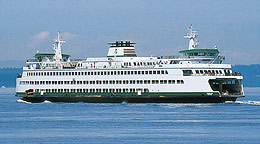
ワシントン州フェリーシステム (WSF) は、米国最大のフェリーシステムです。29 隻の船団が 1 日 500 回以上運航し、ピュージェット湾の島々や半島への通勤者、観光客、車両、商品の輸送に役立っています。
この地域の気象システムは太平洋からワシントン州西部を横切って移動し、ピュージェット湾の風速と風向はオリンピック山脈とカスケード山脈の影響を受けます。表面の風は、システムの気圧の流れに反して偏向したり、集中したりすることがよくあります。パイロット、ワシントン州フェリーの船長、その他の船員の個人的な観察によると、ピュージェット湾の気象状況は、米国海洋大気庁 (NOAA) の沿岸センサーや、国立気象局が運営するこの地域の 4 つのブイ ステーションで記録されている気象状況とは、時として大きく異なることがわかっています。
ワシントン州運輸省は、湾の気象データを一般市民に提供するための取り組みの一環として、7 隻のフェリーに気象観測所を設置する資金を提供しました。気象観測所はフェリー航路沿いの気象パラメータを測定し、フェリー運航者と一般市民に、より正確な天気予報と天気予報のためのデータを提供します。気象観測所は、この地域の独特の地理的および環境的特徴により、これまで入手できなかった気象データを提供します。
1995 年、ワシントン大学海洋学部はスマート フォーラムを設立し、連邦、州、地方の規制当局がピュージェット湾の安全な海上輸送について海洋事業者、管理者、一般市民と情報交換する手段を確立しました。Campbell Scientific社がフェリーに気象観測所を設置することに関わったのは、スマート フォーラムの直接的な成果でした。
気象観測所は、既存のフリート ロケーション システム (FLS) に統合されました。FLS は、WFS が各フェリーの正確な位置を維持し、スケジュールを調整するために使用するリアルタイム フェリー追跡システムです。Meteor Communications Corporation (MCC) は、FLS に Campbell Scientific の機器を提供し、気象観測所をフェリーの FLS システムに統合しました。
各ステーションは、気温、気圧、相対湿度、風速および風向センサーを測定する CR10X データロガーで構成されています。全地球測位システム (GPS) は、グローバル位置座標、対地船舶速度、対地針路を提供します。ジャイロコンパス (GYRO) は、実際の船舶の進行方向を提供します。GPS、GYRO、および CR10X からのデータは、MCC-545A RF モデムに入力され、計測された風速と風向が船舶速度、進行方向、対地針路を使用して補正されます。RF モデムは、補正された風速と風向を CR10X に出力してパネルに表示し、データ レポートを送信します。データは、CR10X にインターフェイスされた LED ディスプレイ パネルを使用して、船上のフェリー船長に表示されます。データは、ワシントン州フェリーのワークステーションにも配信され、ワシントン州フェリーの Web ページに公開されるほか、NWS およびワシントン大学に配布できます。
強風と最大潮流の時期には、一部のフェリーはターミナルスリップに安全に着岸したり、そこから出港したりできなくなります。たった一度の遅延で何千人もの通勤者が大きな不安を抱くため、一部のフェリーに気象観測所を設置し、その後のリアルタイム データを伝送することで、ピュージェット湾の天気という常に変化するパズルの重大なギャップを埋めることができます。
このケース スタディの内容は、以下のソースから (許可を得て) 取得されました。アプリケーションと使用された方法のより詳しい説明については、以下のドキュメントを参照してください。
- Richard J. Fulthorp、BSEE、Meteor Communications Corporation、(MCC) ソフトウェア エンジニアリング、「ワシントン州フェリー移動気象ステーション」。著作権 2000 年 1 月。
- Joseph Nortz、ワシントン州フェリー、および Jay Creech、Meteor Communications Corporation、「Puget Sound 風速データ収集システム」。著作権 1999 年 8 月